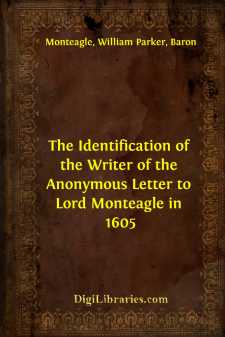Categories
- Antiques & Collectibles 13
- Architecture 36
- Art 48
- Bibles 22
- Biography & Autobiography 813
- Body, Mind & Spirit 142
- Business & Economics 28
- Children's Books 17
- Children's Fiction 14
- Computers 4
- Cooking 94
- Crafts & Hobbies 4
- Drama 346
- Education 46
- Family & Relationships 57
- Fiction 11829
- Games 19
- Gardening 17
- Health & Fitness 34
- History 1377
- House & Home 1
- Humor 147
- Juvenile Fiction 1873
- Juvenile Nonfiction 202
- Language Arts & Disciplines 88
- Law 16
- Literary Collections 686
- Literary Criticism 179
- Mathematics 13
- Medical 41
- Music 40
- Nature 179
- Non-Classifiable 1768
- Performing Arts 7
- Periodicals 1453
- Philosophy 64
- Photography 2
- Poetry 896
- Political Science 203
- Psychology 42
- Reference 154
- Religion 513
- Science 126
- Self-Help 84
- Social Science 81
- Sports & Recreation 34
- Study Aids 3
- Technology & Engineering 59
- Transportation 23
- Travel 463
- True Crime 29
The Identification of the Writer of the Anonymous Letter to Lord Monteagle in 1605
Categories:
Description:
Excerpt
HISTORICAL ANALYSIS
Francis Tresham, of Rushton, in Northamptonshire, has recently (September 11, 1605) succeeded his father, Sir Thomas Tresham (a great sufferer for the Roman Catholic religion), in an inheritance of at least five thousand a year, in present money; after having, as he says, spent most of his time overburdened with debts and wants, and resolves within himself to spend his days quietly. His first cousin, Robert Catesby, being hard-up with funds exhausted in financing the scheme known as the Gunpowder Plot, seeing in Tresham the chance of obtaining a further supply (though previously distrusting him), induces him, in the interests of their religion, to join the conspiracy, of which he thus becomes the thirteenth, and last, sworn conspirator (October 14, 1605). Catesby is careful to impose the oath of secrecy before fully disclosing the plot; of which Tresham, on hearing, entirely disapproves, and endeavours to dissuade his cousin from, or even to defer it; meanwhile offering him the use of his own purse if he will do so. Finding he cannot prevail with him, he is very urgent that the Lords Monteagle and Stourton, particularly the former, may be warned, each having married Tresham's sisters; but Catesby can give no definite assurance. Tresham then intends, as he says, to get the conspirators shipped away, and to inform the Government by some unknown, or anonymous, means.
Tresham has a serving-man named William Vavasour, who attended Sir Thomas Tresham, and who, with his elder brother, George Vavasour (whose education Tresham has particularly encouraged), and their sister Muriel (gentlewoman to Lady Monteagle who is the daughter of "Muriel" Lady Tresham) are favoured dependants of the Tresham family, being the children of an old and much valued Catholic servant. Both George and William are confidentially employed by Tresham as amanuenses, in transcribing religious, or treasonable, treatises of the time.
Lord Monteagle unexpectedly orders a supper to be prepared (October 26, 1605) at his house at Hoxton (belonging to his brother-in-law Tresham), and where he has not been for some months. As he is about to go to supper, a letter is handed to him by his footman, to whom it has been given in the street by "an unknown man of a reasonable tall personage," who knows that he will find him at so unfrequented a residence. Monteagle opens the letter, which is anonymous, pretends he cannot understand it, and shows it to his secretary, Thomas Ward, who, he is aware, is familiar with some of the conspirators; whom Ward, the next evening, tells of the receipt of the letter, which Monteagle at once takes to Whitehall, about three miles away, where he finds the Earl of Salisbury (Principal Secretary of State) with other lords of the Council together assembled, "ready for supper." The Government censor, or suppress, the name of the place where the letter was delivered. The conspirators and the Jesuit priests, who are involved in the plot through the confessional, at once suspect Tresham; and Catesby and Winter directly charge him with having betrayed them, which he denies, while urging them to escape to France, and giving them money for the purpose....


